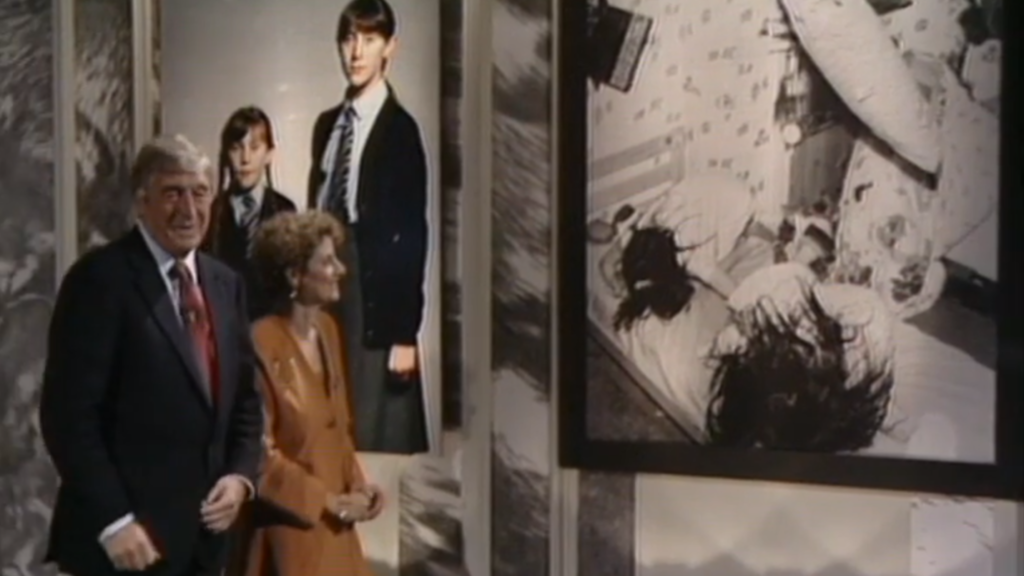Ghostwatch
1992

Rating: NR
Genre: Drama, Horror
Country: U.K.
Run-Time: 1h 31min
Director: Lesley Manning
Cast
Michael Parkinson…..……himself
Sarah Greene………………..…herself
Gillian Bevan…………….…..…Dr. Lin Bevan
Brid Brennen……………………Pamela Early
Ghostwatch only aired once on the BBC. It was dropped on an unprepared public at 9:25 p.m. on Halloween night in 1992 and stirred up such a fuss that the BBC repeatedly spent days doing damage control after receiving a record number of complaints.
But fallout from that Halloween airing kept coming. Five days after Ghostwatch made its way onto British television sets, a 18-year old boy living in a house with faulty pipes (which is how the ghostly “Pipes” gets his name in the show) alluded to the television show in his suicide note. A (later proven false) rumour began to circulate that actress Sarah Greene promoted Ghostwatch on the Saturday morning children’s show she hosted. Then in 1994, a British Medical Journal published an article claiming two 10-year old children were diagnosed with post traumatic stress disorder that stemmed from their exposure to the show.
Of course by then, the BBC had made it a policy never to air, or even discuss, Ghostwatch again. They thought it best to treat the show like it never happened, but people just would not let Ghostwatch fade quietly into the night. In the years that followed, Ghostwatch discussion boards would begin to tell a counter-narrative. It turns out, a lot of those so-called traumatized viewers actually loved the program- many feeling it was one of the most original things the BBC ever aired. In fact, the fandom around Ghostwatch grew so strong that in 2002 the BBC allowed for it to resurface as a 10th anniversary as a DVD release. For its 20-year anniversary, a documentary was produced to discuss the film’s history, impact and legacy.
So what exactly went so terrible wrong for Ghostwatch in 1992?
Well, 1992 was still a time before the Internet was in every household and television was the main form of entertainment, but with far fewer channels. With fewer channels competing for audience attention, the programs that did air had an easier time getting high viewership numbers and a show like Ghostwatch, which popped up on BBC1, the nation’s flagship network, had enough potency to be seen by and traumatize a large segment of the nation.
Also, in 1992 mockumentaries and found footage films were not commonly used horror formats, so the creation of a fictional show designed to look like an actual live broadcast confused some people into thinking what they were watching was really happening- which was made even more believable by the inclusion of the extremely popular real-life talk-show host Michael Parkinson. This caused a small, but significant, segment of the viewing audience to experience something similar to the 1938 War of the Worlds radio broadcast.
In the days that followed. an overzealous press magnified the public outrage against Ghostwatch latching on to any negative story it could find- which came to a head after Ghostwatch was linked to being a contributing factor in an actual suicide.
Having lived through The Blair Witch Project phenomenon– and no, I never thought the Blair Witch was real- I get how gullible some people can be. But the Blair Witch remains stuck in those Maryland woods. Ghostwatch ends implying the broadcast might have influenced a kind of apocalyptic supernatural awakening in the U.K., so anybody who believed the show right up to its end- somehow ignoring the credits at the start and the finish- might have been in for a rough night of sleep…which included a lot of children who sat down and watched the show after a night of trick or treating.
Of course, there are also some reports of adults who also thought the show to be real too. Apparently, giving creator Stephen Volk a writer’s credit in the beginning of the program was not enough to let all viewers in on the act, though the BBC honestly thought it would be since they were trying to avoid similar blowback they got when airing the 1987’s Paul Daniels’ Halloween Special– which ended abruptly, suggesting that the magician was horribly killed during his final trick. (The BBC could be a dark place at times.)
But even if you missed the beginning, the actor who plays Pipes is still credited at the end, which is funny because I didn’t see him once. How unobservant am I?
(Truthfully, the real giveaway that Ghostwatch is fiction is its pacing. A generation who wasted two hours watching The Mystery of Al Capone’s Vault only to have Geraldo Rivera admit that they were not going to find anything special in the basement of the Lexington Hotel should have known the goods that Pipes was offering, and the speed that he was offering it, was just too good to be true. During the film, Parkinson may repeatedly tell us that they will be on air all night if needed to get us evidence of the paranormal, but apparently Pipes only needed a convenient 90-minutes time slot to deliver a perfectly executed, escalating haunting and possession.)
So no. I personally do not hold the BBC responsible for the gullible viewers in the audience in 1992, even though the Broadcasting Standards Commission did.
Ghostwatch starts with Michael Parkinson telling us that this is the debut episode of a new live ghost-hunting show. And, if I am being honest, if it wasn’t for the opening credits, it would be easy to understand how the show might fool some people, at least for a little while. Other recognizable BBC faces, like Sarah Greene and Craig Charles, were also brought in to play themselves- and the show has a genuine feel like this ensemble might really have picked to entertain us weekly searching for proof of ghosts. Also, for a show of this kind, a Halloween debut would have made sense given the concept.
The idea for the show seems simple enough. Sarah Greene would go into a different haunted house every episode, while Michael Parkinson and paranormal investigator Dr. Lin Pascoe (Gillian Bevan) would discuss her findings safely from the studio. In the meantime, Mike Smith would direct calls-ins and Craig Charles would be on location to seve as both skeptic and comic relief while interviewing the mobs of people in the neighbourhood that came to see why a film crew showed up.
For the first episode, we are told that the Early family- consisting of a single-mother with two daughters- was picked because experts felt that their home was the most likely to produce evidence of a real haunting. Of course, it is not coincidental that the Early family’s makeup and experiences are somewhat reminiscent of those of the famous real-world Enfield haunting between 1977-1979, which was also the haunting that is loosely depicted in The Conjuring 2. The Enfield’s had four children, but most of the media attention around that haunting centered around two girls of similar ages to the girls in Ghostwatch.
And for something that aired on television, Ghostwatch doesn’t really pull punches. Mixed in the fictional archival footage are shots of scratches and bruises on the face of the eldest daughter, Suzanne, and these scratches will appear again during the live investigation. Pipes gets a horrifying backstory as a child molester that claimed to be possessed by the spirit of a Victorian baby farmer who it was believed ended up butchering the children she adopted. It was almost as if the program was intentionally trying to scare the bejesus out of children and upset as many adults as possible, so even sensitive viewers that understood what they were seeing was fiction still had plenty to complain to the BBC about. And they did too- in record numbers.
Horror fans will appreciate how Ghostwatch takes full advantage of the uniqueness of its fictional broadcast format. There are only a handful of horrors, like [REC] or Deadstream, that try to transform a found footage-type film into a real-time event, and fewer still that pretend to do it as a live-studio broadcast. A lot of thought and effort went into how to make the broadcast seem realistic, while using the live-event structure to create some innovative scares. Little details matter, like minor glitches in the back and forth operations or asking for previous footage to be queued up. Even the call-ins help in establishing the creepy atmosphere.
Then there’s all those “Where’s Waldo?” style appearances of Pipes scattered throughout the program. (I originally scored a zero, but after the Internet helped me cheat.) It’s a pity that the BBC only aired Ghostwatch once because this aspect of the film is ingenious and definitely benefits from repeat viewings.
Ghostwatch is much better than any made-for-television horror film has any right to be and it still holds up over thirty years later. Now I’ll admit, I’m not a fan of the final few minutes, when supernatural events start to wreak havoc beyond the Early’s household- but in that prior 80-minutes, Ghostwatch delivers a household haunting that is masterful. It is a film that already has a special place in horror for people in the U.K. despite the controversies surrounding its airing. But the film’s reputation as a found footage pioneer and its obvious influence on the films like Paranormal Activity and Late Night with the Devil have helped give Ghostwatch the international recognition it deserves as well.
